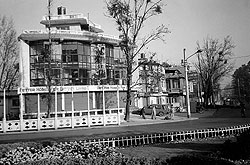In this new weekly feature, Nepali Times will follow up on a previously reported story, update it and pick up where we left off. This week we focus on the pre-SAARC demolition at Tinkune and Maitighar. Nepali Times first covered Tinkune, back in August 2000.
 Bulldozers moved into Tinkune on Sunday and razed shanties in the triangular eyesore on the road from the airport to the city. Next to go are residences and businesses at Maitighar, the triangle near the Army Headquarters.
Bulldozers moved into Tinkune on Sunday and razed shanties in the triangular eyesore on the road from the airport to the city. Next to go are residences and businesses at Maitighar, the triangle near the Army Headquarters.
The landscaping of both Tinkune and Maitighar are part of the government's effort to clean up the cityscape in preparation for the forthcoming summit of the South Asian Association for Regional Cooperation (SAARC) in Kathmandu. The plan is to use the land to build public parks.
Something like this was long overdue for Tinkune, but the haste with which the demolitions were carried out and the uncertainties about compensation have raised hackles against the government. The government issued a public notice giving the owners and tenants at Tinkune just 15 days to vacate the property. On the 15th day the bulldozers arrived and began tearing down the buildings.
"As citizens we expected at least individual notifications, because this was private property," says Rajendra Sharma Parajuli, whose three-storey building was pulled down to the ground. "This is unfair." Like Parajuli, 14 other families claiming ownership of the land, say they will not accept the compensation offered by government because it is far less than prevalent rates.
The government is offering Rs1.6 million, but house owners say Maitighar owners are getting Rs 6.4 million and they should get the same. In "normal" times the Tinkune episode would have attracted much political opposition. But the pressure of pre-SAARC beautification and the emergency mean these are not normal times. "They are willing to give up the land, but they want to be paid equally," Bidur Mainali, deputy Mayor of Kathmandu, told us.  The Tinkune dispute goes back to 1974 when the government first appropriated the land to build a park. It did not build the park, but it did not acquire the land legally either. An earlier feeder road allowed construction within five metres from the centreline, but with the Ring Road, the rule is 15 meters. However, after a lawsuit in the mid-1990s, the Supreme Court ruled that the government had not completed the acquisition procedures, and the landowners moved into what used to be largely open agricultural land.
The Tinkune dispute goes back to 1974 when the government first appropriated the land to build a park. It did not build the park, but it did not acquire the land legally either. An earlier feeder road allowed construction within five metres from the centreline, but with the Ring Road, the rule is 15 meters. However, after a lawsuit in the mid-1990s, the Supreme Court ruled that the government had not completed the acquisition procedures, and the landowners moved into what used to be largely open agricultural land.
The story at Maitighar is slightly different. Ten households have been living in this triangle since 1955 and there were no plans whatsoever to turn this 0.52 ha patch into public space. "I have spent a lifetime here, where can I go and find space to live within this short period?" asks 84-year-old Indira Parajuli. The Parajulis are not as unhappy with having to move out-it is a government decision anyway-but with the way in which the decision was implemented. "The money they are offering is also far less than the government's own evaluation for tax purposes, it is completely unfair," she adds.


